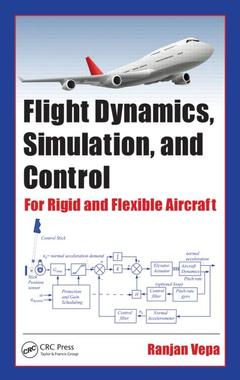Flight Dynamics, Simulation, and Control For Rigid and Flexible Aircraft
Auteur : Vepa Ranjan

Explore Key Concepts and Techniques Associated with Control Configured Elastic Aircraft
A rapid rise in air travel in the past decade is driving the development of newer, more energy-efficient, and malleable aircraft. Typically lighter and more flexible than the traditional rigid body, this new ideal calls for adaptations to some conventional concepts. Flight Dynamics, Simulation, and Control: For Rigid and Flexible Aircraft addresses the intricacies involved in the dynamic modelling, simulation, and control of a selection of aircraft. This book covers the conventional dynamics of rigid aircraft, explores key concepts associated with control configured elastic aircraft, and examines the use of linear and non-linear model-based techniques and their applications to flight control. In addition, it reveals how the principles of modeling and control can be applied to both traditional rigid and modern flexible aircraft.
Understand the Basic Principles Governing Aerodynamic Flows
This text consists of ten chapters outlining a range of topics relevant to the understanding of flight dynamics, regulation, and control. The book material describes the basics of flight simulation and control, the basics of nonlinear aircraft dynamics, and the principles of control configured aircraft design. It explains how elasticity of the wings/fuselage can be included in the dynamics and simulation, and highlights the principles of nonlinear stability analysis of both rigid and flexible aircraft. The reader can explore the mechanics of equilibrium flight and static equilibrium, trimmed steady level flight, the analysis of the static stability of an aircraft, static margins, stick-fixed and stick-free, modeling of control surface hinge-moments, and the estimation of the elevator for trim.
- Introduces case studies of practical control laws for several modern aircraft
- Explores the evaluation of aircraft dynamic response
- Applies MATLAB®/Simulink® in determining the aircraft?s response to typical control inputs
- Explains the methods of modeling both rigid and flexible aircraft for controller design application
Written with aerospace engineering faculty and students, engineers, and researchers in mind, Flight Dynamics,Simulation, and Control: For Rigid and Flexible Aircraft serves as a useful resource for the exploration and study of simulation of flight dynamics.
Introduction to Flight Vehicles. Basic Principles Governing Aerodynamic Flows. Mechanics of Equilibrium Flight. Aircraft Non-Linear Dynamics: Equations of Motion. Small Perturbations and the Linearised, Decoupled Equations of Motion. Longitudinal and Lateral Linear Stability and Control. Aircraft Dynamic Response: Numerical Simulation and Non-Linear Phenomenon. Aircraft Flight Control. Piloted Simulation and Pilot Modelling. Flight Dynamics of Elastic Aircraft. Index.
Dr. Ranjan Vepa earned his PhD in applied mechanics from Stanford University, California. He currently serves as a lecturer in the School of Engineering and Material Science, Queen Mary University of London, where he has also been the programme director of the Avionics Programme since 2001. He conducts research on biomimetic morphing of wings and aerodynamic shape control and their applications to flight vehicles. Dr. Vepa is a member of the Royal Aeronautical Society, London; the Institution of Electrical and Electronic Engineers (IEEE), New York; a fellow of the Higher Education Academy; a member of the Royal Institute of Navigation, London; and a chartered engineer.
Date de parution : 08-2014
Ouvrage de 696 p.
15.6x23.4 cm
Disponible chez l'éditeur (délai d'approvisionnement : 13 jours).
Prix indicatif 184,47 €
Ajouter au panierThèmes de Flight Dynamics, Simulation, and Control :
Mots-clés :
Thrust Specific Fuel Consumption; Tail Plane; Flight Vehicles; Pitching Moment; Aerodynamic Flows; Lift Curve Slope; Equilibrium Flight; Wing Tip Vortices; Non-Linear Dynamics; Lift Coefficient; Perturbations; Aerofoil Section; Equations of Motion; CG Position; Longitudinal Stability; Camber Line; Lateral Linear Stability; Trailing Edge Flaps; Dynamic Response; Aerodynamic Chord; Non-Linear Phenomenon; Spinal Cord; Flight Control; Constant Lift; Piloted Simulation; Pilot Model; Pilot Modelling; Aircraft Angle; Flight Dynam



